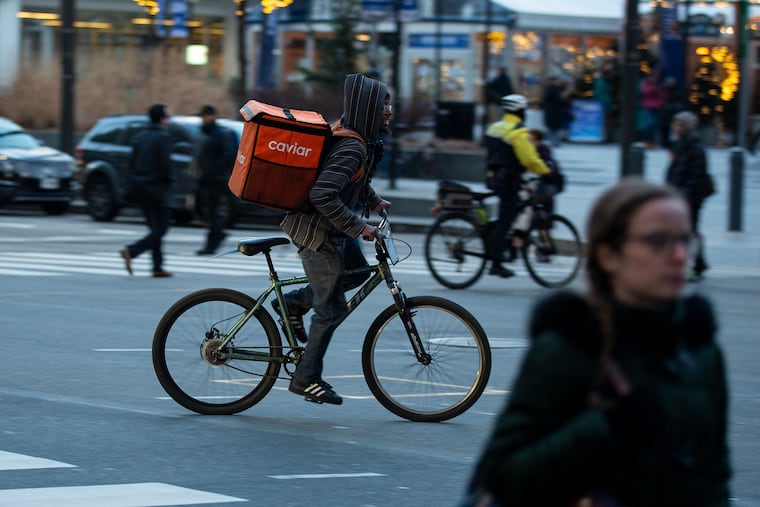Restaurants and customers are getting caught in a food-delivery war
Food-delivery services like Grubhub and DoorDash are getting aggressive, leaving a bad taste in the mouths of restaurateurs and customers.

The food courier last weekend looked familiar to Laura Lyons, who with her husband, Todd, owns Love & Honey Fried Chicken in Northern Liberties.
But when he took out a Love & Honey menu bearing long-outdated items and prices, and attempted to place a takeout order using a credit card bearing the logo of the delivery service Grubhub, she sent him on his way, bird-less.
Love & Honey has an exclusive arrangement with Caviar, a rival delivery service, in exchange for lower fees. Besides, the restaurant no longer offered the exact chicken order requested by the Grubhub courier, who also drives for Caviar.
Why would a Grubhub courier show up at Love & Honey? Grubhub — it turns out — had added Love & Honey to its ordering platform without the Lyonses’ knowledge or permission. The idea, said the company in a public filing in October, is to add convenience to potential customers and to woo new restaurants to its list of 140,000 partner restaurants.
It is not clear if the customer knew or even cared about Caviar’s agreement with Love & Honey. Lyons noted that the order would have been successful if it had been placed through Caviar.
The order was placed via what Grubhub internally refers to as a “Place and Pay,” in which the diner orders through the Grubhub site and the courier places the order with the restaurant, then uses a Grubhub Driver Card to pay for the order. On its driver support site, Grubhub recommends drivers place the order under the diner’s name.
In this case, Place and Pay was a failure — to the delivery driver, to Love & Honey, and to Grubhub’s customer, who just wanted a box of fried chicken, for crying out loud.
“We look bad to our customers,” Lyons said. After peppering Grubhub with direct messages on Twitter and sharing her gripes with fellow restaurateurs on Facebook and Instagram, she said she received a call from a Grubhub executive who apologized and agreed to remove Love & Honey immediately from Grubhub’s site and app.
It’s another skirmish in the escalating war for food delivery — a $10.2 billion-a-year industry in 2018, according to Technomic, which gauges the impact of technology on the economy.
Besides Caviar and Grubhub, the companies sending messengers out in the Philadelphia area include UberEats, Postmates, and the nation’s largest service, DoorDash. The future of Caviar, a relatively small player, is uncertain since DoorDash bought it for $410 million last summer.
Analysis by Second Measure, which studies consumer behavior, said that in November, Grubhub had 42% of the Philadelphia-area food-delivery spending, followed by DoorDash (combined with Caviar) at 39%, UberEats at 16%, and Postmates with an unspecified smaller percentage.
Meanwhile, restaurants and customers face an array of options and confusion.
Just type a restaurant name and the word delivery into a search engine — for example, Mike’s BBQ, in South Philadelphia.
Caviar, which has an exclusive with Mike’s BBQ, is at the top of search results. But up high are what appear to be Mike’s BBQ listings on DoorDash and Grubhub; both are unaffiliated with the restaurants. DoorDash’s menu offers a rack of ribs for $14, while the correct and current Mike’s menu on Caviar sells it for $16. (Since owner Michael Strauss reached out to GrubHub last weekend demanding removal, the Mike’s BBQ listing on Grubhub does not work.)
Further complicating the situation at Mike’s is that the restaurant sells out of barbecue almost daily. “The drivers [from another service] would come in for a rack of ribs, and we just didn’t have it,” Strauss said.
Strauss himself was on the other end of a botched transaction. He said he went to DoorDash to order food from Lucky’s Last Chance in Manayunk and waited for 90 minutes. “Finally, the driver from DoorDash called me and said, ‘We don’t have a contract with them,' ” Strauss said, adding that he called Lucky’s owner, Chris Barnes, who grumbled about the situation.
Billions of dollars are at stake nationally. Lyons estimated that 30% of the business at Love & Honey is pickup and delivery. Delivery does not come cheap, for the business or the consumer. Restaurants negotiate deals with the services, but the fees can be up to 35% on every order, devouring slim profits. Customers pay delivery fees of 99 cents to $5, as well as service charges keyed to the price of the order.
Second Measure said the food-delivery war will intensify because diners are losing their loyalty to one service. Its report said that in the third quarter of 2017, 83% of Grubhub customers didn’t use other services. Two years later, that had fallen to 61% as competing services expand their offerings and tout promotional prices.
Some businesses choose not to strike deals of exclusivity. The Philadelphia fast-casual eatery chain Honeygrow is available on various platforms, as it solicits orders on the web, via its app, and through offsite kiosks.
Honeygrow sells particularly well on DoorDash, whose “tech stack” is compatible with Honeygrow’s kiosks, said Keith Fitzgerald, Honeygrow’s vice president of technology. Besides, he said, “we want to meet the guest wherever they are."